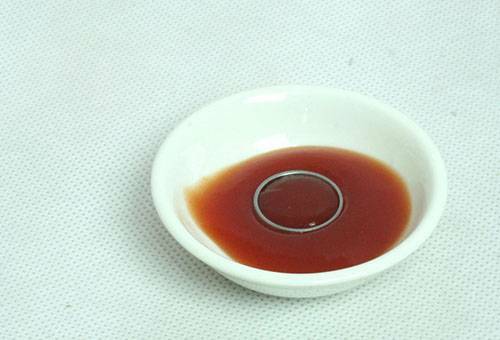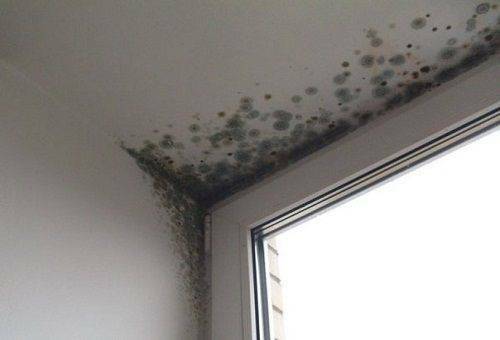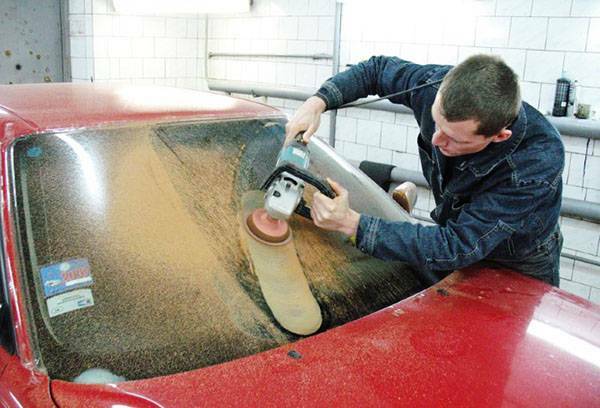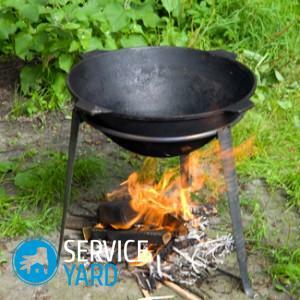
- Why should I cast iron cauldron?
- How and where to burn cast-iron cauldron?
- How correctly to heat the cauldron?- Instructions for action
- How to prepare the cauldron for first use with salt?
- Quenching with oil
- How to take care of cast iron dishes?
- How to prepare aluminum cauldron for first use?
- How to choose a cauldron?
One of the leaders in the preparation of almost any hot food, especially dishes of Central Asian cuisine, is cauldron. Thanks to the peculiarities of its manufacture and structure, cast-iron thick plates create unique conditions for the preparation of any dishes. In addition, you can use the cauldron at least on the stove, even in a Russian stove, even at the stake. However, after buying cast-iron utensils, you can not immediately start gastronomic witchcraft - you need to prepare the dishes. Today we will tell you how to heat a cast-iron cauldron and why to prepare utensils for the first use.
to the contents ↑Why should I cast iron cauldron?
The need for this procedure is explained by the way the product is manufactured. Kazan is cast in a certain form of cast iron, and in order for the product to easily come out of the mold, it is densely poured with technical oil. In addition, oil is also needed to protect dishes from rust, because iron is an alloy of iron with a small percentage of carbon, which means that such material is susceptible to corrosion.
Naturally, such a lubricant does not give the food any taste, no pleasant smell, no benefit. On the contrary - the remains of engine oil on the inside of the cauldron make food unfit and inedible. Hence - the procedure for calcination of cast iron is vital. Fortunately, this can be done quite simply. From the lucky owner of the kazan, only caution and exact adherence to the instruction are required.
Below we will introduce you how to prepare the cauldron for first use without any excesses and damage to expensive dishes.
to the contents ↑How and where to burn cast-iron cauldron?
There is no doubt that it is necessary to get rid of the industrial grease, for this purpose the cast iron is calcined. The process procedure is quite simple: it is necessary to raise the temperature of the material to a value at which the factory grease starts to burn and turn into smoke and soot. Smoke will come out naturally, and soot is easily washed off with warm water.
Important! You can deal with the process both on the street and at home. Of course, it is better to carry out the process of calcination of dishes on the street, but if this is not possible, you will have to open all the windows at home and turn on the hood, since the smell from the burnt grease will be palpable.
There are two ways how to calcine cast-iron cauldron at home:
- Gas burner. Place the dishes on top of the fire. The material will quickly heat up, and the factory lubricant will quickly burn out, forming a carbon monoxide. After the cauldron has fully warmed up and the oil is burned, leave the dishes to cool completely( to room temperature).Then wash the cauldron thoroughly.
- Oven. Preheat the oven to 200 degrees, you can and above. Place the cauldron on a baking tray. Leave the dishes for three hours. During this time, the factory grease will burn. As soon as the cauldron cools down, wash it and operate it as directed.
For more details about the process of calcination, we will describe below.
If you decide to ignite cast iron on the street, then you can use for this purpose:
- Mangal.
- Bonfire.
- Oven.
- Another source of heat, giving the necessary temperature in the focus of heat and flame.
Important! Do not worry about cast iron, as it is impossible to melt it at the stake, but the grease will burn completely. However, do not forget about safety: gently treat with open fire, and to remove dishes from fire use tight potholders or cloth folded several times.
to the table of contents ↑How correctly to roast the cauldron?- Instruction for action
To avoid various incidents and excesses, strictly follow the instructions:
- New cauldron rinse with warm water outside and inside.
- Remove excess moisture.
- Put the dishes on fire.
- Wait until the cauldron starts to smoke and smells unpleasant. This means that the temperature is sufficient to burn the grease.
- Calculate the utensils until the dark spots disappear from the surface.
Important! To burn out engine oil is necessary until the smoke stops smoking.
- Extinguish the fire.
- After the dishes cool down, remove it from the heat source.
- After the cauldron has cooled, but it will still be hot, moisten the paper napkin( rag) in vegetable oil and wipe the surface with soot.
- Dry the cauldron dry.
- Apply a thick oil to the inside of the cast iron with a brush. You can use linseed oil or sesame oil for this purpose. In food it is not good, but for the processing of utensils most times.
- Put the cauldron on an average fire and warm until smoke is gone. Make sure that the oil film falls evenly. Brush the streaks with a brush.
How to prepare the cauldron for first use with salt?
The essence of this method is the adsorbing properties of table salt. Sodium chloride is the only inorganic component that a person uses for food.
Use the salt as follows:
- Wash the cauldron with warm water.
- Dilute the fire.
- Add a large salt pack to the cauldron.
- Calcinate salt for three hours( no more), stirring occasionally. During this time the salt will absorb excess moisture and harmful compounds of the factory lubricant.
- Turn off the fire.
- Wait until the dishes cool down and discard the salt.
- Kazan Wash off soot particles.
Important! After the first procedure of calcination( with or without salt - unimportantly), one more is needed using vegetable oil. This is necessary in order for the oil to form a protective film to prevent corrosion of the metal.
to the contents ↑Calculation with oil
So, Kazan no longer smokes. But in order to ensure the further ease of care for the dishes and prevent the appearance of corrosion, it is necessary to conduct another calcination, using already vegetable oil.
Proceed as follows to properly calcinate the cast-iron cauldron and ensure its long service life:
- Pour 400-700 ml of oil into the cooled cauldron - depending on the volume of the dishes.
- Spread the oil throughout the inside of the cauldron.
- Light the fire and set the average power on the burner.
- Simmer the cauldron with oil for 30 minutes, periodically turning it so that the oil covers all the walls. Use a brush or special paper to achieve full surface coverage with oil. The oil must penetrate even into the pores of hot iron to form the finest coating, which will not allow food to burn in the future.
- Drain the oil.
- Wipe off the surface with a cloth or cloth.
Important! After processing the dishes, boil water in it, if you can make tea with this water, then you have done everything right.
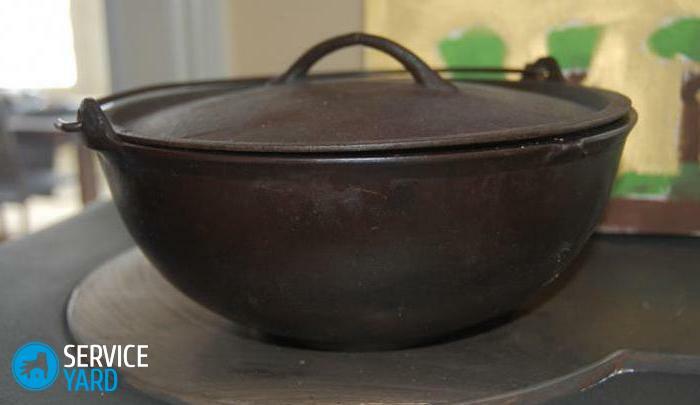 If the dimensions of the oven allow, then cauterize the cauldron with the oil in it. This method is longer, but less smoky:
If the dimensions of the oven allow, then cauterize the cauldron with the oil in it. This method is longer, but less smoky:
- Preheat the oven to 180-200 degrees and leave the dishes for 3 hours.
- To prevent oil from reaching the bottom of the oven, protect it with foil.
- You can cover the cauldron with oil sludge in several layers( 3-4).
- Wrap a paper towel on the brush and pour 10 grams of oil into the kazan.
- Rinse the oil on the walls and put one more cycle.
Important! At 180 degrees the cycle can take 5 hours, and at 250 degrees, it takes thirty minutes. The cycle is considered complete if the next layer loses its stickiness.
to the table of contents ↑How to take care of cast-iron dishes?
There are several important fundamental points, the observance of which will allow using conventional cast-iron cauldron for many years and turn it into a tool for the reproduction of kitchen masterpieces.
Rules for cleaning utensils made of cast iron:
- Do not use detergents for cleaning cauldron. They destroy the protective grease. It is enough to rinse the cauldron after use with clean warm water, and remove the remaining food with a soft sponge or nylon wool.
- Do not wash iron utensils using metal brushes. Cast iron is extremely sensitive to microdamages. In scratches and cracks, moisture can accumulate, which subsequently leads to corrosion.
- Do not drop the dishes and gently move it from place to place. Handle with iron utensils neatly, since, despite the fact that the cauldron is very heavy, it is still fragile, and can crack or crack during a fall.
- Do not allow sharp changes in temperature when using the cookware. It is strictly forbidden to pour cold water into a hot cauldron, since it can burst from such treatment.
Tips:
- If the cauldron after long-term storage rusted, then clean it with a stiff sponge or sandpaper. Then wash and burn. After such procedures, Kazan will be as good as new.
- After preparing the dish and cleaning the dishes, always lubricate the surface with vegetable oil, using a rag or an oiled cloth.
- If cast iron is covered with a thick layer of soot from the outside, then remove the plaque with an old knife or spatula. If possible, use a sandblast for this purpose. She quickly and carefully removes the layer of burning and does not damage the material. After treatment, rinse the cauldron in warm water and burn it with oil.
- To get rid of the smell in the cauldron, put it on the fire and burn with salt for 30-40 minutes, stirring regularly and spreading over the surface. After the treatment, salt is removed, let the cast iron cool down and wipe the inside surface with napkins. Then heat the pot and oil with vegetable oil, using a brush or paper.
How to prepare aluminum cauldron for first use?
Aluminum cauldron costs less than its cast-iron counterpart, and it is much easier. The dishes from aluminum very quickly heats up and just as quickly cools, so the effect of languor, as in cast-iron utensils, will not be. Aluminum is a low-melting material, so prepare the cauldron for first use with caution. The procedure of calcination should be carried out at medium temperature.
Important! The purpose of calcination of aluminum caustic is to create a film of oxides on the surface. After this procedure, free aluminum can not get into the food or react with some ingredient.
Methods of calcination
The following methods are used for the preparation of aluminum cauldron for first use:
- Open flame. You can crock the dishes on the street at the stake or at home on the stove, but with one condition - the fire should be below average. For a fire, use raw firewood, which will not give a high procedure. Duration of calcination - no more than 1.5 hours. In addition, for utensils of aluminum during processing it is necessary to follow. Otherwise, you risk not calcining, but melting the boiler.
- Table salt. The principle of processing is the same as with cast-iron dishes, but the conditions are the same - a weak fire, the duration of the procedure is 1.5 hours. Salt after treatment should be cream-brown in color. After the calcination procedure, discard the salt.
- Vegetable oil or animal fat. Aluminum cast iron does not rust, since the alloy contains no iron. Therefore, a method using oil can be omitted. The only condition is to coat the surface with an oiled cloth or cloth so that the products do not burn later.
Important! If you want to use vegetable oil for calcination, then carry out the procedure in the same way as with a cast-iron counterpart, but on low heat and no more than 1.5 hours.
Rules for the care and storage of aluminum caoutchouc:
- Do not clean aluminum cookware with abrasives or metal wool. Otherwise, you will damage the layer of aluminum oxide, the dishes will begin to burn, and the metal will get into food.
- Wash dishes in warm water immediately after cooking. If the food has dried, use classic liquid detergents or laundry soap and a soft sponge. After - reheat the dishes and grease with vegetable oil.
- It is absolutely forbidden to wash the cauldron in the dishwasher.
- Store the cauldron in a dry and well-ventilated place.
- Dry thoroughly before storing the kettle and open the lid.
- If the food is burnt, put the dishes on fire, pour water and add a few spoons of salt and soda. Boil the solution for 20-30 minutes. Rinse with running water using a soft sponge.
- After cleaning, regularly lubricate the cauliflower with oil.
How to choose a cauldron?
Manufacturers offer 3 types of dishes, which can be called kazankami:
- Cast-iron cauldrons. This is heavy and massive dishes. It needs calcination. It will last long enough, and the more often you cook in such a cossack, the better. A good cauldron will only get better with time.
- Aluminum cauldrons. After the first preparation, the surface of the dishes is covered with a film protecting food from burning, and food from harmful metal. This film can not be violated. This type of cookware is perfect for electric cookers, as aluminum cauldron heats faster than others.
- Kazan with non-stick coating. Tableware of traditional shape, similar to a pan. The downside of such utensils is the instability of the coating. Over time, the film may deteriorate and flake.
When choosing a kazan for a family, buy it with a small margin, for example:
- for cooking for 4-6 people choose 7-8 liters of cauldron;
- if you use dishes for the reception of guests, then buy a pot with large volume.
The choice is also influenced by the place of preparation: if you cook at home, then buy flat bottom utensils so that the cauldron stays stable on the stove.
Important! When buying cookware, be sure to inspect the inner surface for signs of cracks, cracks and welding traces. If the influx is still "treated" with a grinder or grinding discs, then cracks or traces of trying to brew them - this is a clear marriage. If it is cracked once, it will crack in the second. So it's better to refuse such a purchase.
And finally: do not store food in a cast-iron cauldron, but eat it immediately, with good appetite and good mood!

